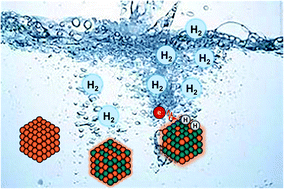Computational design of (100) alloy surfaces for the hydrogen evolution reaction†
Abstract
With the rapid development of kinetically-controlled techniques, synthesis of cubic bimetallic catalysts with tunable components and compositions becomes possible. In recent years, many of the bimetallic alloy catalysts with (100) as the predominant facet have shown outstanding electrocatalytic activity and stability. However, alloying effects on the activity at (100) were less explored, compared to the well-studied close-packed surfaces. Here, using density functional theory (DFT) calculations, we explore the catalytic activity of bimetallic alloy (100) surfaces for the electrocatalytic hydrogen evolution reaction (HER). The ensemble and compositional effects of (100) facets alloyed by strong- (Pd and Pt) and weak-binding (Ag, Au, and Cu) transition metals were studied. Based on DFT calculations, the catalytic activities of bimetallic alloys for the HER were systematically investigated using H binding energy as the reaction descriptor, at all of the typical surface ensembles on (100). Our results suggest that PdxAg1−x and PdxAu1−x(100) have promising theoretical HER activity in acidic media, due to the presence of highly active four-fold ensembles which reach the peak of the HER volcano activity plot. The electronic structure and stability of the alloys with predicted promising HER activities were studied. Furthermore, based on the DFT-calculated database, we performed feature analysis and developed a machine learning model which can help to predict HER activities of those out-of-sample alloys. Most importantly, this study provides helpful guidelines for the design of (100) dominated bimetallic alloys towards promising HER activity.

- This article is part of the themed collections: Editor’s Choice: Machine Learning for Materials Innovation and Journal of Materials Chemistry A Emerging Investigators


 Please wait while we load your content...
Please wait while we load your content...